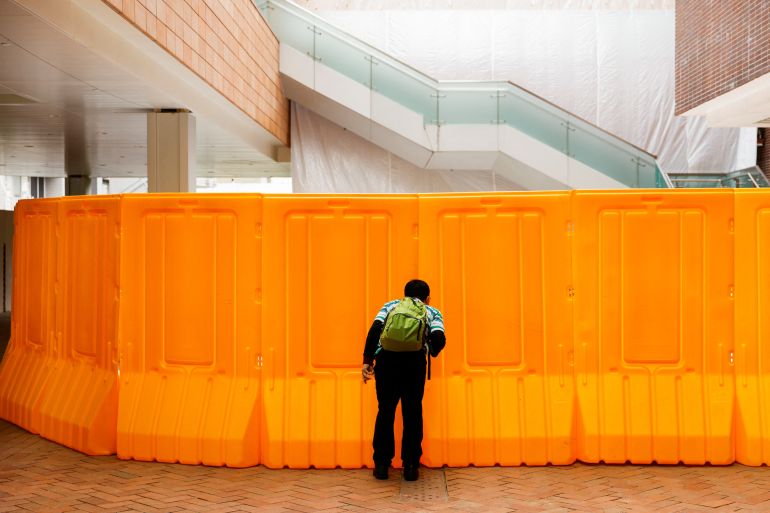Two more Tiananmen Massacre monuments taken down in Hong Kong
Lingnan University dismantles Tiananmen Massacre relief, while another piece, Goddess of Democracy, was removed from the Chinese University of Hong Kong.

A liberal arts university in Hong Kong has taken down a relief depicting events during the deadly 1989 Tiananmen Square crackdown, a day after a similar artwork was removed from another leading academic institution in the Asian financial hub.
Lingnan University officials blocked off early on Friday the area where the Tiananmen Square Massacre sculpture was installed before removing it, according to the Lingnan University Students’ Union Press Bureau.
Keep reading
list of 3 itemsHong Kong activists sentenced for banned Tiananmen vigil
Will Hong Kong’s ‘patriotic’ election herald a new era?
In a social media post, Hong Kong-based photographer and columnist Galileo Cheng also confirmed the removal of Chinese-born New Zealand artist Chen Weiming’s 6.4 metres (21 feet) by 3.2 metres (10.5 feet) piece, which was installed at the university in 2010.
Lingnan University was quoted in a statement as saying that the decision to remove the piece was for the “general interest of the university community”.
Chen’s Goddess of Democracy sculpture was also removed from The Chinese Univesity of Hong Kong (CUHK) on Friday, according to a report by Citizen News.
The 2008 statue is made of copper and is an imitation of the original monument erected by Chinese students in 1989 and was paraded in the middle of Tiananmen Square just before the crackdown. It became a symbol of defiance and freedom for the protesters.
The Goddess of Democracy sculpture was also exhibited by Chen in Washington DC in 2009.
Cheng, the columnist and photographer, wrote on social media that a Goddess of Democracy painting on the wall of Lingnan Univesity’s student union office was also painted over on Friday.
A @lingnanuni spokesperson said they "recently reviewed & assessed items on campus that may pose legal and safety risks to the University community. In the best interest of the University, items in question have been cleared, or removed & stored appropriately.” pic.twitter.com/1mJS75VyjA
— Hong Kong Free Press HKFP (@hkfp) December 24, 2021
In a separate statement, CUHK said the university “never authorised the display of the statue on its campus, and no organisation has claimed responsibility for its maintenance and management.”
It also noted that as early as 2010, when the statue was first installed, it already received a request from the Chinese University Student Union to display it on campus.
It added that the university did not approve the request “and its opposition and principles are on the public record”.
The removal of Chen’s works is just the latest step targeting people or organisations affiliated with the sensitive June 4, 1989 date and events to mark it.
In an interview with Hong Kong Free Press, Chen said he is “concerned about whether the monuments are damaged and where they are placed currently”, adding that he will contact his lawyers in the US to explore his legal options.
Authorities have been clamping down in Hong Kong under a China-imposed national security law that human rights activists say is being used to suppress civil society, jail democracy campaigners, and curb basic freedoms and free expression.
Authorities say the law has restored order and stability after massive street protests in 2019. They insist freedom of speech and other rights remain intact and that prosecutions are not political.
China has never provided a full account of the 1989 Tiananmen Square crackdown. Officials gave a death toll of about 300, but rights groups and witnesses say thousands may have been killed.
On Thursday, the University of Hong Kong dismantled and removed a statue known as the Pillar of Shame, one of the few remaining public memorials in the former British colony to remember the bloody 1989 crackdown that is a taboo topic in mainland China, where it cannot be publicly commemorated.
The statue was a key symbol of the wide-ranging freedoms promised to Hong Kong at its 1997 return to Chinese rule.
Hong Kong has traditionally held the largest annual vigils in the world to commemorate the Tiananmen Square crackdown.
Danish sculptor Jens Galschiot, who created the statue, said in a statement he was “totally shocked” and that he would “claim compensation for any damage” to his private property.
In a separate interview with Al Jazeera, Galschiot called the removal a “crime against democracy”.